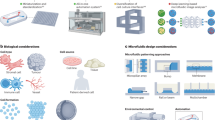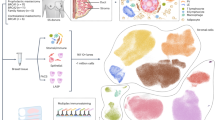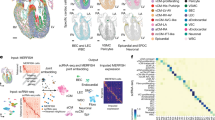Abstract
Previous studies have shown that maintenance of undifferentiated human embryonic stem (hES) cells requires culture on mouse embryonic fibroblast (MEF) feeders. Here we demonstrate a successful feeder-free hES culture system in which undifferentiated cells can be maintained for at least 130 population doublings. In this system, hES cells are cultured on Matrigel or laminin in medium conditioned by MEF. The hES cells maintained on feeders or off feeders express integrin α6 and β1, which may form a laminin-specific receptor. The hES cell populations in feeder-free conditions maintained a normal karyotype, stable proliferation rate, and high telomerase activity. Similar to cells cultured on feeders, hES cells maintained under feeder-free conditions expressed OCT-4, hTERT, alkaline phosphatase, and surface markers including SSEA-4, Tra 1-60, and Tra 1-81. In addition, hES cells maintained without direct feeder contact formed teratomas in SCID/beige mice and differentiated in vitro into cells from all three germ layers. Thus, the cells retain fundamental characteristics of hES cells in this culture system and are suitable for scaleup production.
This is a preview of subscription content, access via your institution
Access options
Subscribe to this journal
Receive 12 print issues and online access
$209.00 per year
only $17.42 per issue
Buy this article
- Purchase on Springer Link
- Instant access to full article PDF
Prices may be subject to local taxes which are calculated during checkout



Similar content being viewed by others
References
Thomson, J.A. et al. Embryonic stem cell lines derived from human blastocysts. Science 282, 1145–1147 (1998).
Reubinoff, B.E., Pera, M.F., Fong, C.Y., Trounson, A. & Bongso, A. Embryonic stem cell lines from human blastocysts: somatic differentiation in vitro. Nat. Biotechnol. 18, 399–404 (2000).
Amit, M. et al. Clonally derived human embryonic stem cell lines maintain pluripotency and proliferative potential for prolonged periods of culture. Dev. Biol. 227, 271–278 (2000).
Smith, A.G. et al. Inhibition of pluripotential embryonic stem cell differentiation by purified polypeptides. Nature 336, 688–690 (1988).
Williams, R.L. et al. Myeloid leukaemia inhibitory factor maintains the developmental potential of embryonic stem cells. Nature 336, 684–687 (1988).
Kleinman, H.K. et al. Isolation and characterization of type IV procollagen, laminin, and heparan sulfate proteoglycan from the EHS sarcoma. Biochemistry 21, 6188–6193 (1982).
Bisell, D.M., Arenson, D.M., Maher, J.J. & Roll, F.J. Support of cultured hepatocytes by a laminin-rich gel. J. Clin. Invest. 79, 801–812 (1987).
Bodnar, A.G. et al. Extension of life-span by introduction of telomerase into normal human cells. Science 279, 349–352 (1998).
Cooper, A.R. & MacQueen, H.A. Subunits of laminin are differentially synthesized in mouse eggs and early embryos. Dev. Biol. 96, 467–471 (1983).
Ekblom, P., Vestweber, D. & Kemler, R. Cell–matrix interactions and cell adhesion during development. Annu. Rev. Cell Biol. 2, 27–47 (1986).
Hynes, R.O. Integrins: versatility, modulation and signaling in cell adhesion. Cell 69, 11–25 (1992).
Hierck, B.P. et al. Variants of the α6β1 laminin receptor in early murine development: distribution, molecular cloning and chromosomal localization of the mouse integrin α6 subunit. Cell Adhesion Commun. 1, 33–53 (1993).
Cooper, H.M., Tamura, R.N. & Quaranta, V. The major laminin receptor of mouse embryonic stem cells is a novel isoform of the α6β1 integrin. J. Cell Biol. 115, 843–850 (1991).
Kim, N.Y. et al. Specific association of human telomerase activity with immortal cell lines and cancer. Science 266, 2011–2015 (1994).
Weinrich, S.L. et al. Reconstitution of human telomerase with the template RNA component hTR and the catalytic protein subunit hTRT. Nat. Genet. 17, 498–502 (1997).
Acknowledgements
We thank Mohammad Hassanipour for technical assistance, Dr. Ram Mandalam for evaluating frozen CM, Drs. Choy-Pik Chiu, Calvin Harley, and Jane Lebkowski for insightful discussions and critical review of the manuscript, Dr. Peter Andrews (University of Sheffield, UK) for Tra 1-81 and Tra 1-60 antibodies, and Hybridoma Bank (Iowa City, IA) for SSEA-1 and SSEA-4 antibodies.
Author information
Authors and Affiliations
Corresponding author
Rights and permissions
About this article
Cite this article
Xu, C., Inokuma, M., Denham, J. et al. Feeder-free growth of undifferentiated human embryonic stem cells. Nat Biotechnol 19, 971–974 (2001). https://doi.org/10.1038/nbt1001-971
Received:
Accepted:
Issue Date:
DOI: https://doi.org/10.1038/nbt1001-971
This article is cited by
-
Learning Towards Maturation of Defined Feeder-free Pluripotency Culture Systems: Lessons from Conventional Feeder-based Systems
Stem Cell Reviews and Reports (2024)
-
Development of synthetic modulator enabling long-term propagation and neurogenesis of human embryonic stem cell-derived neural progenitor cells
Biological Research (2023)
-
Truncated vitronectin with E-cadherin enables the xeno-free derivation of human embryonic stem cells
Scientific Reports (2023)
-
The adaptation of bovine embryonic stem cells to the changes of feeder layers
In Vitro Cellular & Developmental Biology - Animal (2023)
-
Thyroid hormone enhances stem cell maintenance and promotes lineage-specific differentiation in human embryonic stem cells
Stem Cell Research & Therapy (2022)



